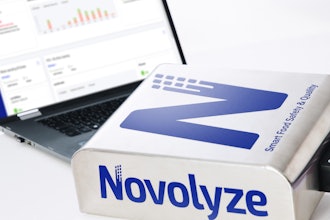
 Ziv Paz
Ziv PazIn many traditional asset-heavy industries, such as machinery manufacturing, processes have not been digitally modernized. Some processes on the production floor are not quantified, or there is no data to monitor the effectiveness of the process, nor the ability to find operational flaws and improve them. Industrial companies have begun to deploy Internet of Things (IoT) systems on the production floor to obtain intelligence that can improve operational efficiencies, foresee future maintenance requirements, and invariably, deliver smarter and faster business decisions.
Specialized machine sensors, local-based compute and storage platforms, networking infrastructures, and machine learning algorithms that collect data at every step of the production process, are being developed to address this new age of Industrial Internet of Things (IIoT). In conjunction with machine-to-machine (M2M) communications and big data analytics, IIoT technologies are driving higher levels of machine efficiency, preventative action, productivity and performance. The abundance of data associated with IIoT is creating new challenges for manufacturing businesses, requiring a storage strategy that collects data locally from the edge and moves it up to the cloud.
Sifting through this massive amount of data is a task for big data analytics. To assist with analysis, artificial intelligent algorithms look for patterns in the data to identify and alert operators regarding anomalies, as well as opportunities for process improvement that can potentially save a company substantial time and money. In an industry where system or machine failures, power losses, or unplanned downtime, can place a company in a risky or critical situation, IIoT technology can change all of that.
Not to be confused with IoT, where devices provide conveniences and automation at the consumer level, IIoT refers to connected machines and devices in manufacturing. Data growth in IIoT is sky rocketing, and is the fastest growing and largest segment in IoT. IIoT manufacturing will account for a significant amount of the overall manufacturing spend in 2017, and expected to achieve a total spend of almost $124 billion by 2021.
As these machines and devices stream an abundance of sensor data, and as network connectivity is an expensive resource (not always available with a guaranteed bandwidth), supporting IIoT technology requires a storage strategy with a combination of local and cloud-based storage.
IIoT Storage Requirements
A comprehensive IIoT system will have two distinct use cases. The first is to respond to developing situations. The second is to review and analyze historical data, looking for areas where the process can be improved so the working artificial intelligent agents can be trained to monitor the system. These use-cases require different compute and storage solutions. The ability to respond to real-time changes requires that the data be immediately accessible and locally available (edge storage), while data used for model (or process) training, can reside in the cloud, either private or public depending on the company’s policy.
Edge Computing in IIoT Environments
Edge storage enables devices that are portable, used in the field, or used on the factory floor, to store data locally without dependency on network availability or from the impact of network latency. Always-on network connectivity is expensive in terms of monthly or data fees, but is also expensive in terms of power consumption relating to the IIoT sensor. Eliminating this need is desired, not only from a functional perspective, but also from an operational cost advantage. Edge storage also provides added value from a security/privacy aspect.
There are two ways to generate data locally in an IIoT environment. For the first, the compute and storage elements reside directly within the sensor itself — in many instances as part of the machine. In this scenario, the computing element performs local data analytics while the storage element stores data locally on the machine itself. A good example is PCB vision inspection test equipment that stores testing logs locally and requires cloud storage only for the model training.
For machine sensors that do not create a lot of data, such as serial number readers or sensors that generate Go/No-Go or Pass/Fail output, there is no need to dedicate a storage device (or a compute device) to that particular sensor. In this scenario, the strategy is to send the data through a local wired or wireless network — a gateway — that sits on the production floor but is located at the edge of the enterprise.
Therefore, the IIoT storage strategy includes a combination of machine sensors that have their own embedded local storage and lower level sensors that are mounted on machines and connect locally to an edge gateway that typically performs the following functions:
- Connects to the outside world
- Collects, aggregates and filters data close to industrial processes or production assets
- Performs local analysis to detect anomalies in real time or raises alarms to operators to take actions
- Translates data from disparate formats into a backend-supported protocol
Future Connected Factory Trends
The ideal storage strategy is to not funnel all of the data to the cloud, but instead, use a combination that stores data locally at the machine-level, as well as an edge gateway at the factory-level to aggregate data locally, not expose it to the outside world, and translate it into a common format that the cloud can use for longer-term data storage.
Flash-based storage devices (removable or embedded) are used for both machine and cloud data storage. For local machine storage, the flash memory is at the edge of a network and serves more as short-term cache. Short term is relative, but the data will remain in machine storage as long as it has value, which can be a few hours or a few weeks. Once the relevancy of the data becomes older and colder, it can be moved to cloud storage or discarded to make room for new data. Due to the constant cycling of data at the edge, the bar for flash device endurance is extremely high, requiring customers to deploy industrial grade storage devices.
Final Thoughts
The data deluge associated with IIoT is creating new challenges for manufacturing businesses in the midst of their own digital transformations and particularly true as it relates to the storage side of big data. To support the real-time needs of connected machines, critical systems and devices on the factory floor, a hybrid storage strategy that collects data from the edge and moves it up to the cloud is recommended.
Ziv Paz is a Director of Product Marketing in the Embedded and Integrated Solutions group at Western Digital Corporation.























